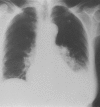Chlamydial zoonoses
- PMID: 20358033
- PMCID: PMC2847324
- DOI: 10.3238/arztebl.2010.0174
Chlamydial zoonoses
Abstract
Background: Zoonoses were already a subject of intense interest even before the SARS and avian influenza epidemics arose. For many years, chlamydiae have been hypothesized to be important zoonotic pathogens, because of their wide distribution and their infectious cycle. This article provides an overview of the current state of knowledge on this subject.
Methods: The authors present a selective review of the literature as well as their own findings.
Results: The scientific knowledge of the distribution and infectious cycle of chlamydiae is still inadequate. The laboratory diagnosis of chlamydial zoonoses remains unsatisfactory in both human and veterinary medicine, as there are no commercially available sensitive and species-specific tests. Acute chlamydial infections are usually treated with macrolides, tetracyclines, or quinolones. Persistent varieties are not covered by standard therapy.
Conclusions: There is a considerable need for research on chlamydial infections, especially with regard to the diagnosis and treatment of persistent varieties.
Figures



References
-
- Beeckman DS, Vanrompay DC. Zoonotic Chlamydophila psittaci infections from a clinical perspective. Clin Microbiol Infect. 2009;15:11–17. - PubMed
-
- Barbeyra CB. Genital Chlamydia trachomatis infections. Clin Microbiol Infect. 2009;15:4–10. - PubMed
-
- Wright HR, Turner A, Taylor HR. Trachoma. Lancet. 2008;371(7):1945–1954. - PubMed
-
- Vila-Corcoles A, Ochoa-Gondar O, Rodriguez-Blanco T, Raga-Luria X, Gomez-Bertomeu F. Epidemiology of community-acquired pneumonia in older adults: a population-based study. Respir Med. 2009;103:309–316. - PubMed
-
- Sachse K, Schubert E. Aviäre Chlamydiose als Quelle humaner Ornithose – eine wenig beachtete Infektionskette. Ärztebl Thüring. 2005;16:411–413.
Publication types
MeSH terms
LinkOut - more resources
Full Text Sources
Medical
Miscellaneous

